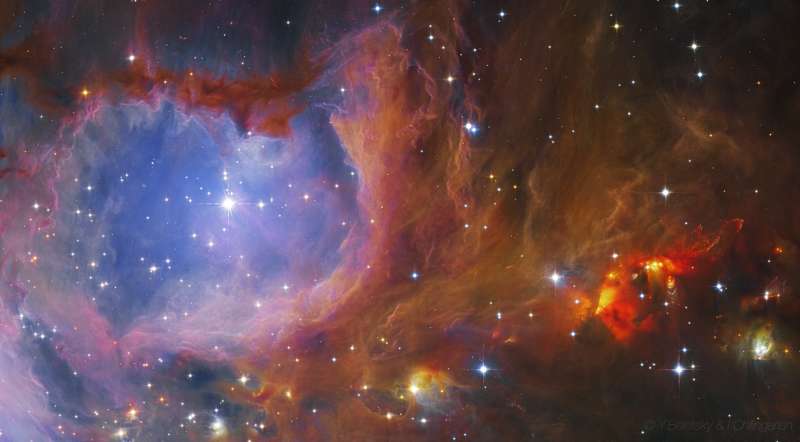
|
Credit & Copyright: Yuri Beletsky
(Carnegie
Las Campanas Obs.),
Igor Chilingarian
(Harvard-Smithsonian CfA)
Explanation:
Often imaged
but rarely mentioned,
Messier 43
is a large star forming region in its own right.
It's just part of the star forming complex of gas and dust that
includes the larger, more famous neighboring Messier 42,
the Great Orion Nebula.
In fact,
the Great Orion Nebula itself lies off the lower edge of
this scene.
The close-up of Messier 43 was made while testing the
capabilities of a near-infrared instrument with one of the twin
6.5 meter Magellan telescopes
at Las Campanas Observatory in the Chilean Andes.
The composite image shifts the otherwise invisible infrared wavelengths
to blue, green, and red colors.
Peering into
caverns of interstellar dust hidden from
visible light, the near-infrared view can also be used
to study cool, brown dwarf stars in the complex region.
Along with its
celebrity neighbor, Messier 43 lies about
1,500 light-years away, at the edge of Orion's giant molecular cloud.
At that distance, this field of view spans about 5 light-years.
|
January February March April May June July August September October November December |
| ||||||||||||||||||||||||||||||||||||||||||||||||
NASA Web Site Statements, Warnings, and Disclaimers
NASA Official: Jay Norris. Specific rights apply.
A service of: LHEA at NASA / GSFC
& Michigan Tech. U.
Based on Astronomy Picture
Of the Day
Publications with keywords: star formation - infrared
Publications with words: star formation - infrared
See also:
- APOD: 2025 July 10 Á Lynds Dark Nebula 1251
- APOD: 2025 June 23 Á W5: Pillars of Star Formation
- APOD: 2025 April 28 Á Gum 37 and the Southern Tadpoles
- APOD: 2025 March 26 Á Star Formation in the Pacman Nebula
- APOD: 2025 February 23 Á Saturn in Infrared from Cassini
- APOD: 2024 October 22 Á M16: Pillars of Star Creation
- Star Factory Messier 17
